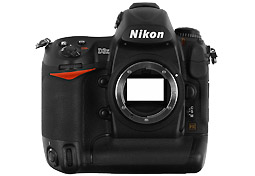Key sensor characteristics
The Nikon D3X features a very high resolution full-frame format CMOS sensor with 24.6Mpix. The D3X and the Sony A900 are the only two cameras at that level of resolution within the professional D-SLR category, but the D3X features a 14-bit Analog/Digital (A/D) converter which, as shown below, plays a significant role in boosting its capture performance when compared to the Sony A900 (with only a 12-bit A/D converter).
The D3X’s lower ISO setting (down to ISO 78) compared to other Nikons certainly help as some dxomark metrics such as dynamic range are considered at lowest ISO values.
Key performance factors
The D3X sensor shows exceptional dynamic range with a max DR of 13.7 bits in “Print” mode. And it is quite an amazing performance compared to all other cameras with similar sensor technologies (Canon 1Ds MKIII, 5D MKII, Sony A900). Interestingly, the Nikon D3X sensor does follow the theoretical rule of plus 1 f-Stop of dynamic range when ISO sensitivity is divided by 2. Compared to A900, dynamic range is better by about 1 stop across the whole ISO range (50-6400).
It is the first DSLR CMOS sensor with more than 12-bit effective depth of information! Its 14-bit A/D makes a difference and we can expect exceptional tone scale reproduction with such a camera.
Further the D3X’s Color Depth is also exceptional, with a maximum value of 24.7 bits of color discrimination performance (in normalized “Print” mode). As the D3X color responses are pretty close to those of the D3, we can expect the same high quality color rendering.
The Nikon D3X has some limitations at high ISO sensitivity, and its dynamic range is lower than, for instance, the Canon 5D MKII for speeds above 800 (manufacturer value).
Overall, however, Nikon D3X definitely takes the lead within its category and will be remembered as the first camera clearly demonstrating more than 12-bit effective depth of information.
Nikon D3X DxOMark review – January 15, 2009
Disclaimer: This dxomark review evaluates only the selected camera’s RAW sensor performance metrics (i.e., Color Depth, Dynamic Range, and Low-Light ISO), and should not be construed as a review of the camera’s overall performance, as it does not address such other important criteria as image signal processing, mechanical robustness, ease of use, flexibility, optics, value for money, etc. While RAW sensor performance is critically important, it is not the only factor that should be taken into consideration when choosing a digital camera.





DXOMARK encourages its readers to share comments on the articles. To read or post comments, Disqus cookies are required. Change your Cookies Preferences and read more about our Comment Policy.